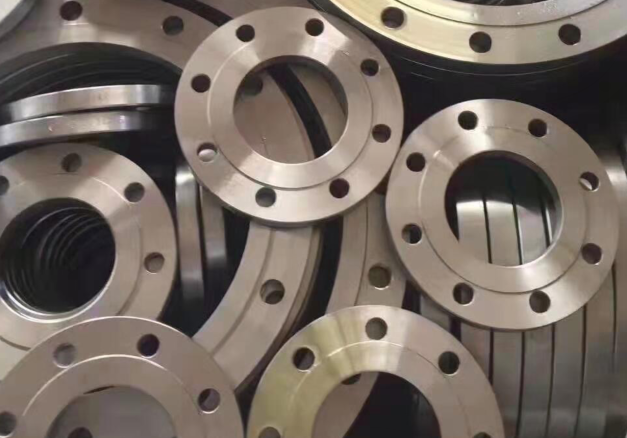
Flanges are divided into threaded connection flanges, welding flanges and clamping flanges. Flanges are always used in pairs, low-pressure pipelines can use wire flanges, and welding flanges can be used with pressures above four kilograms. Add a sealing gasket between the two flanges and tighten them with bolts. Flanges of different pressures have different thicknesses and use different bolts. When water pumps and valves are connected to pipelines, some parts of these equipment are also made into corresponding flange shapes, also called flange connection.

Any connecting parts that are closed together by bolts on the two planes at the periphery are generally called "flanges", such as the joints of ventilation ducts. This kind of parts can be called "flange parts". But this connection is only a part of the equipment, Such as the connection between the flange and the water pump, It is not easy to call the water pump "flange parts". Relatively small ones, such as valves, can be called "flange parts". Reducer flange is used to connect the motor and the reducer, as well as the connection between the reducer and other equipment.
What is SCH 80?
SCH 80 (Schedule 80) represents the wall thickness, which refers to XS thickened pipes with a pressure wall thickness less than DN200mm. Usage scenarios generally involve high temperature, high pressure, and highly corrosive conditions. The wall thickness of SCH 80 grade pipes is relatively thick, and the pressure and temperature in the use environment must comply with ASME/ANSI standards to ensure the safety and reliability of the pipeline system. SCH 80 grade piping systems are often used in the manufacture of chemical equipment, high-pressure pipelines, high-temperature heaters and some special piping systems. When designing and installing a steel pipe system, it is necessary to select the appropriate pipe number according to the actual use environment to ensure the stability and safety of the pipeline system.
Standard specification for SCH 80 pipe flange:
The standard specification for SCH 80 carbon steel pipe fittings is an important guarantee for ensuring the safety and quality of pipeline system operations. Various standard-setting organizations at home and abroad have formulated corresponding standards, such as the international pipe fitting standard ASME B16.9, the domestic steel pipe fitting standard GB/T12459, etc. There are corresponding regulations on the specifications, dimensions, surface treatment, pipe wall thickness, etc. of pipe fittings.
The internationally accepted pipe flange standards can be summarized into two different and non-interchangeable pipe flange systems: one is the European pipe flange system represented by Germany; the other is the American pipe flange system represented by the United States.
Quality control of pipe flange fittings:
Quality control of pipe flange fittings is the key to ensuring the quality and safety of the pipeline system. The quality inspection of pipe fittings includes appearance quality inspection, chemical composition analysis, physical performance testing, non-destructive testing and other aspects. Only pipe fittings that have passed the inspection can be put into use to ensure the safe and effective operation of the pipeline system.
According to the connection method, flange connection types can be divided into: plate flat welding flange, neck flat welding flange, neck butt welding flange, socket welding flange, threaded flange, flange cover, neck butt welding ring Loose sleeve flange, flat welding ring loose sleeve flange, ring grooved surface flange and flange cover, large diameter flat flange, large diameter high neck flange, eight-shaped blind plate, butt welding ring loose sleeve flange, etc.
A gasket is a ring made of material that can produce plastic deformation and has a certain strength. Most gaskets are cut from non-metallic plates or made by professional factories to specified sizes. The materials are asbestos rubber plates, asbestos plates, PTFE plates, polyethylene plates, etc.; thin metal plates (tinplate, tinplate, etc.) are also used. Stainless steel) A metal-clad gasket made by wrapping non-metallic materials such as asbestos; there is also a wound gasket made of thin steel strips and asbestos strips. The most commonly used ones are stainless steel strips and graphite. Metal wound gaskets, depending on the use environment, the wrapping tape can also be made of asbestos. Ordinary rubber gaskets are suitable for situations where the temperature is lower than 120°C; asbestos rubber gaskets are suitable for situations where the water vapor temperature is lower than 450°C, the oil temperature is lower than 350°C, and the pressure is lower than 5MPa. Medium, the most commonly used is acid-resistant asbestos board. In high-pressure equipment and pipelines, lens-shaped or other-shaped metal gaskets made of copper, aluminum, No. 10 steel, and stainless steel are used. The contact width between the high-pressure gasket and the sealing surface is very narrow, and the processing smoothness of the sealing surface and gasket is high.
SCH 40 pipe vs SCH 80 pipe flange fittings:
The main difference between SCH 40 and SCH 80 pipe flange fittings is the wall thickness. SCH 40 pipe has a thinner wall thickness and is often used in low-pressure applications such as residential plumbing or irrigation systems. SCH 80 pipe elbow fitting has thicker walls and is used in high-pressure applications such as industrial processes, hydraulic systems and underground piping. They are designed to handle higher pressures and withstand greater stresses than SCH 40 pipe.
Looking at specific dimensions, the wall thickness of SCH 40 pipe is approximately 0.109 inches, while the wall thickness of SCH 80 pipe is approximately 0.154 inches. This means that SCH 80 pipe is approximately 30% thicker than SCH 40 pipe. While SCH 80 pipe is stronger and more durable than SCH 40 pipe, they are also more expensive.
SCH 80 pipe has thicker walls and requires more material and more manufacturing time, which increases costs. When selecting pipe for a specific application, it is important to consider the pressure requirements and the cost-effectiveness of selecting thicker, more expensive pipe.
Related information
